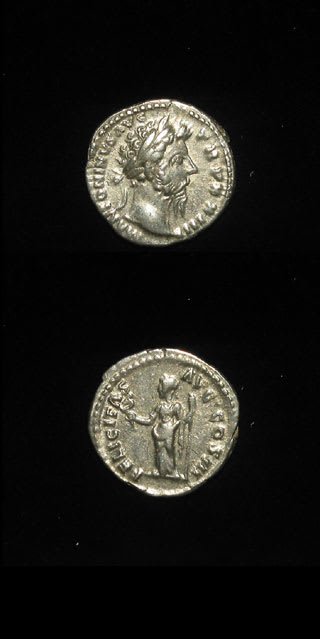Silver Denarius of Emperor Marcus Aurelius, 161 CE - 180 CE
Silver
C.4065
Obverse: M ANTONINVS AVG TR P XXIIII; Laureate Bust of the Emperor Facing Right Reverse: FELICITAS AVG COS III; Felicitas Standing to the Left, Holding a Caduceus and a Sceptre...
Obverse: M ANTONINVS AVG TR P XXIIII; Laureate Bust of the Emperor Facing Right
Reverse: FELICITAS AVG COS III; Felicitas Standing to the Left, Holding a Caduceus and a Sceptre
This well-preserved coin in VF condition was struck for the emperor Marcus Aurelius. Coinage operates as a propagandist device in all cultures, and particularly during the Roman Empire when the borders were uncertain and internal strife threatened to destabilise the economy. The iconography is fairly unambiguous, and shows the powerful emperor associating himself and the Roman state with Felicitas, the goddess of good luck and success. The significance of this is presumably to highlight the success he had had in the governorship of the empire. A caduceus is a herald’s sceptre, and should not be confused with the medical symbol which is the Rod of Asclepius. It was held originally by Iris, the messenger of Hera, and subsequently by Hermes. The fact that it is shown here may represent Marcus Aurelius being informed of the happiness of his people.
Born Marcus Annius Catilius Severus in 121 AD, Marcus Aurelius’ family was well-connected to the aristocracy and ruling classes of Rome, including Hadrian, Trajan and Antoninus Pius. He attracted the attention of Hadrian at a young age, and was nicknamed verissimus – truest. Following the death of Hadrian’s adoptive son Lucius Aurelius, Hadrian named Antoninus as his successor on the condition that he adopt Marcus as well as Lucius Aurelius Verus, the son of his own adopted son, and that they succeed him as emperor in their turn. He acceded to power in 161, aged 40, and adopted the name Marcus Aurelius Antoninus.
The empire grew under his authority, with martial success against the Parthians and Germania, and diplomatic relations with states in Central Asia as far east as Han China. His Meditations, written while on campaign, is still used as a reference for leadership and duty and proposed a manner of rational virtue. He was a Stoic philosopher of considerable note, as well as a family man who took his wife and children with him on his trips around the empire. He had fourteen children by Faustina the Younger, of which only one son and four daughters survived him. He was deified upon his death from the Antonine Plague in 180, and was succeeded by Commodus.
This is a striking and attractive ancient coin.
Reverse: FELICITAS AVG COS III; Felicitas Standing to the Left, Holding a Caduceus and a Sceptre
This well-preserved coin in VF condition was struck for the emperor Marcus Aurelius. Coinage operates as a propagandist device in all cultures, and particularly during the Roman Empire when the borders were uncertain and internal strife threatened to destabilise the economy. The iconography is fairly unambiguous, and shows the powerful emperor associating himself and the Roman state with Felicitas, the goddess of good luck and success. The significance of this is presumably to highlight the success he had had in the governorship of the empire. A caduceus is a herald’s sceptre, and should not be confused with the medical symbol which is the Rod of Asclepius. It was held originally by Iris, the messenger of Hera, and subsequently by Hermes. The fact that it is shown here may represent Marcus Aurelius being informed of the happiness of his people.
Born Marcus Annius Catilius Severus in 121 AD, Marcus Aurelius’ family was well-connected to the aristocracy and ruling classes of Rome, including Hadrian, Trajan and Antoninus Pius. He attracted the attention of Hadrian at a young age, and was nicknamed verissimus – truest. Following the death of Hadrian’s adoptive son Lucius Aurelius, Hadrian named Antoninus as his successor on the condition that he adopt Marcus as well as Lucius Aurelius Verus, the son of his own adopted son, and that they succeed him as emperor in their turn. He acceded to power in 161, aged 40, and adopted the name Marcus Aurelius Antoninus.
The empire grew under his authority, with martial success against the Parthians and Germania, and diplomatic relations with states in Central Asia as far east as Han China. His Meditations, written while on campaign, is still used as a reference for leadership and duty and proposed a manner of rational virtue. He was a Stoic philosopher of considerable note, as well as a family man who took his wife and children with him on his trips around the empire. He had fourteen children by Faustina the Younger, of which only one son and four daughters survived him. He was deified upon his death from the Antonine Plague in 180, and was succeeded by Commodus.
This is a striking and attractive ancient coin.



